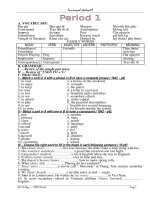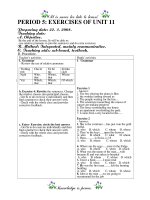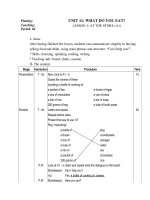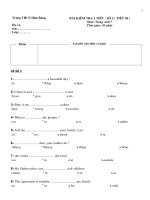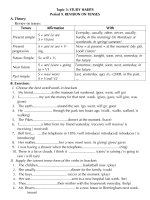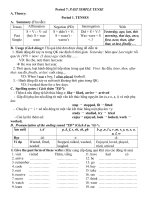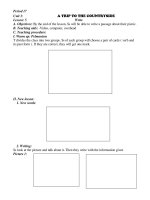Period 66-99
Bạn đang xem bản rút gọn của tài liệu. Xem và tải ngay bản đầy đủ của tài liệu tại đây (220.54 KB, 63 trang )
Planing:
Teaching:
Period: 66
Unit 11: what do you eat?
Lesson 1: at the store (a1)
I- Aims.
After having finished the lesson, students can communicate simplity in buying/
selling food and drink, using noun phrases and structure: “Can I help you?”.
* Skills: listening, speaking, reading, writing
* Teaching aids: board, chalk, cassette.
II- The content.
Stage Interaction Procedure Time
Presentation T - Ss Now, look at A1 - b
Guess the names of these
(cooking) a bottle of cooking oil
a packet of tea a dozen of eggs
a box of chocolates a can of peas
a kilo of rice a bar of soap
200 grams of beg a tube of tooth paste
15
Practice T - Ss Listen and repeat
Repeat before class
Present the way to use “of”
Play “matcching”
a bottle of beg
a dozen a toothpaste
a box of aranges
a tube of water
a kilo of tea
a packet of chocolates
200 grams of rice
20
P.W
P.W
Look at A1 - a, listen and repeat write the dialogue on the board.
Storekeeper: Can I help you?
Vui: Yes, a bottle of cooking oil, please.
Storekeeper: Here you are?
Vui: Thank you
P.W Make the similar dialogue, using the food and drink in A1 - b reed before
class.
Production T - Ss Now, complete the following dialogue
A: ........... I ........... you?
B: Yes, a ........... of ..........., please.
A: ........... ........... ...........
B: Thank you.
10
Homework T - Ss Learn by hear A1, 2
III- Evaluation.
Content:
..........................................................................................................................
..........................................................................................................................
Method:
..........................................................................................................................
..........................................................................................................................
Result:
..........................................................................................................................
..........................................................................................................................
Planing:
Teaching:
Period: 67
Unit 11: what do you eat?
Lesson 2: at the store (a2, 3)
I- Aims.
After having finished the lesson, students can communicate in buying talk
about needs and wants, ask and answer about quantities and the way to use “how
much...”, “How many...”
Skills: listening, speaking, reading, writing
Teaching aids: board, chalk, cassette
II- The content.
Stage Interaction Procedure Time
Warm - up T - Ss Matching: a bottle of chocolates
a box of cooking oil
a dozen of soap
a bar of eggs
a tube of toothpaste
5
Pre - listen T - Ss Now, look at the picture in A2 and say what people often ask and answer
when they buy or sell.
(listen and repeat 3 times)
present: Gram: (1000 gram = 1 kilo)
anything: vËt, viÖc g×
else: kh¸c, n÷a
In English, there are (noun) countable noun and uncountable noun
* in countable noun, there are singular, plural: an orange/ oranges...
- There is no “an/ a” before un-countable noun.
Eg: water
* To ask and answer about quartities.
Eg: eggs, apples
How many apples/ eggs do you want?
Water, milk: How much water do you want?
I want............../ I need.....................
10
While - listen T - Ss Now, listen 3 times and fill the information in the list.
Items Quantity
Beg 200g
Eggs A dozen
Now, base on the list answer the questions below
20
P.W a. Ba is at the store
b. He wanst some beef and eggs
c. He wants 200 grams of beef.
d. He want a dozen eggs.
Now, look at A3 listen and match the name of the people with what they
wait.
Post - listen G.W Use the network to sort the following list
Wine, orange, water, pen, cheese, butter, milk, glass of milk, het, rice, tea,
soap
How many how much
10
P.W Practice to ask and answer about them
Homework T - Ss Make the similar dialogue, base on network
III- Evaluation.
Content:
..........................................................................................................................
..........................................................................................................................
Method:
..........................................................................................................................
..........................................................................................................................
Result:
..........................................................................................................................
..........................................................................................................................
Planing:
Teaching:
Period: 68
Unit 11: what do you eat?
Lesson 3: at the store (a4)
I- Aims.
Further practice for students about the way to ask and answer needs, want,
quantity review the old vocabulary, structures.
- Skills: listening, speaking, reading, writing.
- Teaching aids: board, chalk
II- The content.
Stage Interaction Procedure Time
Warm - up T - Ss What would you like? I’d like..../ I like..........
How much........ do you heed/ want? I need/ want...
5
Pre - read T - Ss Give students cards with the content of A4 but they are mixed.
Key:
7
G.W Rearrange the dialogue
Write the result on the board. - listen and check
Listen 3 times student repeat.
(Practice) P.W Take the play the dialogue
While - read T - S Read the dialogue again and answer
1. Can Nam go to the store for his Mon?
2. What does she need?
3. How much rice does she need?
4. How many oranges does she need?
* Make a shopping list, follow the content.
23
P.W
Items Quantities
Cooking oil
Rice...
Beef
Oranges
A bottle
2 kilos
half a kilo
half a dozen
Now, P.W about them.
Post - read T - Ss Base on the words “foods and drinks” make the similar dialogue A4. 10
P.W
Homework T - Ss Make a “shopping list” then make the dialogue base on it.
III- Evaluation.
Content:
..........................................................................................................................
..........................................................................................................................
Method:
..........................................................................................................................
..........................................................................................................................
Result:
..........................................................................................................................
..........................................................................................................................
Planing:
Teaching:
Period: 69
Unit 11: what do you eat?
Lesson 4: at the canteen (b1, 3, 4)
I- Aims.
After having finished the lesson, students will further know the name of foods
drinks, fruits, review the old vocabulary, structune.
Skills: listening, speaking, reading, writing
Teaching aids: board, chalk, cassette
II- The content.
Stage Interaction Procedure Time
Warm - up T - Ss Make questions and answer, using the words “How many/ much?”
a dozen eggs; apples/ 2 kilos; milk/ a bottle
5
Pre - listen T - Ss
P.W
Now, look at B1 and do you remember these?
Prepque in 2 minutes then one ask other answer from the first to the end.
What is this? It’s rice.
a. rice b. noodle c. beef
d. chicken e. fish f. bananas
g. aranges h. vegetables i. Orange juice
k. soda l. water m. milk
7
While - listen T - Ss Now, listen and number (3 times)
Give the correct answer
T (gives) asks and the questions in B3 - students answer
23
P.W Practice to ask and answer about the things in B1, using structures in B3.
What would you like for lunch/ breakfast/ dinner? I’d like
How much/ many....... do you like/ need/ want?
Eg:
What would you like for breakfast?
I’d like bread and milk
How many breads do you want?
I want 2 breads
How much milk do you need?
I need a quster kilo of milk.
Post - listen P.W Practice to ask and answer about yourself and your friend
What would your father like for luch?
How much/ many... does he like/ need/ want?
10
Homework T - Ss Make a dialogue to ask about your mother, using the structure above.
III- Evaluation.
Content:
..........................................................................................................................
..........................................................................................................................
Method:
..........................................................................................................................
..........................................................................................................................
Result:
..........................................................................................................................
..........................................................................................................................
Planing:
Teaching:
Period: 70
Unit 11 (cont)
Lesson 5: at the canteen (b2, 5)
I- Aims.
After having finished the lesson, students can (speak, write) ask and answer
about the price, using vocabulary: hundred, thousand, cake, ice-cream, fried
- rice: + structure: How much is/ are............ It is.....................
They are.............
- Skills: listening, speaking, reading, writing
- Teaching aids: cassette, boards, chalk
II- The content.
Stage Interaction Procedure Time
Warm - up T - Ss Play “network”
water rice
a bottle of a kilo of
a dozen
eggs
5
Presentation T - Ss Now, listen and repeat B2 3 times
Write on the board: 2.500- two thousand fine hundred
100- one hundred
1.000- one thousand
guiding to read country numbers (ask about the pice)
⇒ Priclock “How much are they?” They are + st
Then present: How much is it? It is + st
7
Practice T - Ss
P.W
Now, listen again then practice to read
Notice: “How much........ (for the price)”
“How much........ (for the quanlity)”
now, listen 3 times B5 then present.
Friend rice, a bowll of noodle, sandwich, cake, ice-cream or look at B5 and
show the name of food or drink.
18
Requine student to read the name of it and its price.
P.W Now, read B5 again the one asks one answer base on menu.
Eg: How much is a friend rice? It’s 2,500®
How much is a boul of noodles? It’s 3,000®
How much is a sandwich? It’s 1,500®
How much is a cake? It’s 500®
How much are an orange Juice and a lemon Juice?
They are 1,800® and 1,000®
How much is an ice - cream? It’s 2,000®
Production T - Ss
P.W
Look at something in your classroom ask and answer about the price.
Eg: How much is a pen? It’s 1,000®
15
Home-work T - Ss Write 5 sentences to ask and answer about somethings you know.
III- Evaluation.
Content:
..........................................................................................................................
..........................................................................................................................
Method:
..........................................................................................................................
..........................................................................................................................
Result:
..........................................................................................................................
..........................................................................................................................
Planing:
Teaching:
Period: 71
Unit 11 (cont)
Lesson 6: grammar practice
I- Aims.
Futher practice in likes and dislikes (simple present tense) countablity, using
adjectives, questions words, present progressine VS simple present, quantifiers.
Skills: listening, speaking, reading, writing.
Teaching aids: board, chalk
II- The content.
Stage Interaction Procedure Time
Warm - up T - Ss Give a table and require to choose
Find someone who.... Name
... likes fish
... doesn’t like chicken
... like bread
... doesn’t like rice
... like milk
... doesn’t like soda
... doesn’t like ...
Lan
Ba
3
Presentation T - Ss * Present simple entence
S + V(s/ es)
Ex1: a/ like? - like.................. do........... like?.............. I don’t like
7
Practice P.W B/ Does......... like?....... like, - Does - like?............ doesn’t like
Repeat the way to use articles “a/ an/ any/ some”.
Let students prepare in 2 minutes.
(2) a/ any........? ... any........ some........ an
b/ ........ some? ........ some
c/ ........ some ........ some ........ a
Now, look at the board and make an example then complete.
30
Individual Ex3: adjectines
a/ He isn’t tall. He is short f......... cold
c.............. light d.............. strong g.............. thin
b.............. thin e.............. full h.............. long
repeat “WH - question” or question word
Ex4: (Who, What, Where, How, When)
Now, listen and check
a. Who b. What c. How
d. What e. Where
repeat the creation and the way to use present simple and present
progressive (S + be + V_ing)
(5) Contrast: (prepair in 5 minutes) then listen to check
a/ .............. is eating d/ .............. is going
b/ .............. are drinking e/ .............. is getting
c/ .............. is f/ .............. is traveling
Production T - Ss Change the following sentences in to present progressive
1. We learn English
2. Lan travels to TN city
5
Homework T - Ss Doing Exercises in Grammar practice again on your book.
III- Evaluation.
Content:
..........................................................................................................................
..........................................................................................................................
Method:
..........................................................................................................................
..........................................................................................................................
Result:
..........................................................................................................................
..........................................................................................................................
Planing:
Teaching:
Period: 72
KiÓm tra 1 tiÕt
I- Aims.
Checking the know ledges from Unit 9 to 11 with language focus “article, the
present simple tense, the present progressine, the price,...”.
- Students can understand do exercise and get at least 5 marks.
- Skills: listening, reading, writing
- Teaching aids: photos of the test
II- The content.
Question Points Key
I- Listen and complete the following sentences
1- She.............. to Ho Chi Minh..............
2. They.............. working.............. the garden
2 I-
a. travels.............. aty
2. are.............. in
II- Choose the correct word in the brasket
1. He a. want some patatoes
b. wants
- Are there a. some potatoes?
b. any
c. an
- Yes, there are a. some
b. any
c. a
2. I don’t a. an cup of ice-coffee
b. a
c. some
and she doesn’t like a. an orange
b. any
c. a
but we’d like a. an box of chocolate
b. a
c. some
3. He a. feel hungry. He’d like some rice
3 II-
1. b. wants
b. any
a. some
2. b. a
a. an
b. a
3. b. feels
b. feels
and some chicken but he doesn’t a. like beef
b. likes
4. How a. much eggs do you want?
b. many
A dozen eggs and three kilos of apples.
- How a. much is a dozen eggs?
b. many
a. It’s is one thousand fine hundred.
b. They are
- How much a. is three kilos of apples?
b. are
They are 9.500®
a. like
4. b. many
a. much
a. It is
b. are
III- Rearrange the words in the sentences.
1. like/ what/ she/ would/ breakfast/ for?
.....................................................................................
she/ some/ ‘d like/ breads/ milk/ and
.....................................................................................
2. rice/ chicken/ and/ do/ you/ like?
.....................................................................................
No/ like/ I/ don’t/ chicken and rice
.....................................................................................
2 III-
What would she like for breakfast?
She’d like breads and milk.
2. Do you like rice and chicken?
No, I don’t like chicken and rice
IV- Fill the suitable question word in the gap.
1.......... is in the classroom? Students in the classroom
2.......... are they doing? They’re learning English
3.......... is the teacher? He is in th classroom
3 IV-
1. Who..........
2. What..........
3. Where..........
* Homework: Prepare Unit 12 A1, 2,3
III- Evaluation.
Content:
..........................................................................................................................
Method:
..........................................................................................................................
Result:
..........................................................................................................................
Planing:
Teaching:
Period: 73
Unit 12: sports and pastimes
Lesson 1: what are they doing?
(a1, 2, 3)
I- Aims.
After having finished the lesson, students can further know the names of sports
and patimes, review the present progrressive tense, present simple.
Skills: listening, speaking, reading, writing.
Teaching aids: cassette, board, pictures.
II- The content.
Stage Interaction Procedure Time
Presentation T - Ss Look at A1 and answer the question
What are they doing?
Now, listen and repeat
Now, tell me the name of games.
a. To swim d. to skip g. tennis
b. badminton e. Volleyball h. To jog
c. soccer f. acrobics i. Table tennis
train to read.
Give the picture and require students to write the name of game.
7
Practice T - Ss Require students to evaluate the sentence in A1
Repeat the structure of structure progressive
S + be + V_ing
28
P.W What is he/ she doing? He/ she is.............
What are they doing? They are...............
What are you doing? I am......................
* Change into interrogative.
He is swimming → Is he swimming? Yes, he is.
No, he isn’t
(3) listen and repeat
which sports do you play?
Listen and repeat A3 and guess the meaning of it.
P.W Practice to ask and answer
Production T - Ss Play “Nought and crosses” 10
P.W
Lan/ skipping I/ table tennis We/ not swim
Huong/ acrobies Which/ you play They/ play soccer
Hung/ jogging Your brother/ soccer Your sister
Homework T - Ss Make 5 sentences, using the present progressive with the favorite sports.
III- Evaluation.
Content:
..........................................................................................................................
..........................................................................................................................
Method:
..........................................................................................................................
..........................................................................................................................
Result:
..........................................................................................................................
..........................................................................................................................
Planing:
Teaching:
Period: 74
Unit 12: sports and pastimes
Lesson 2: what are they doing (a4, 5)
I- Aims.
After having finished the lesson, students can speak, write about the sports, ask
and answer about the ports that other can play. Review the names of the sports and
the present simple tense.
Skills: listening, speaking, reading, writing.
Teaching aids: board, chalk, cassette
II- The content.
Stage Interaction Procedure Time
Presentation T - Ss Look at A4 and answer.
Who is this? This is Lan
3
Practice T - Ss
Individual
Now, read about Lan
Ask students to read before class. Then read about Nam.
Nam and Lan like sports very much. They play many sports.
- Make the table and fill the information in reading.
32
Namesports
Lan acrobics, swimming, badminton
Nam soccer, table tennis, jogging
P.W Now, look at the table and answer the questions.
a. She swims, she does acrobics and plays badminton
b. No, she doesn’t
c. He jogs, he plays soccer, table tennis.
d. Yes, he does.
P.W Practice to ask and answer.
Which sports do you play? I....................
(5) Write
G.W a. ask your partner 5 write
eg: A: Which sports do you play?
B: I play soccer.
C: I skip
b. Write about the sports you play
I play volleyball
I jog
P.W I skip
Production T - Ss Answer the questions: Which sports does your mother/ father/ teacher play? 10
Homework T - Ss Write 5 sentences about the sports you like and often play.
III- Evaluation.
Content:
..........................................................................................................................
..........................................................................................................................
Method:
..........................................................................................................................
..........................................................................................................................
Result:
..........................................................................................................................
..........................................................................................................................
Planing:
Teaching:
Period: 75
Unit 12 (cont)
Lesson 3: free time (b1 - 4)
I- Aims.
After having finished the lesson, students can ask and answer about pastimes,
write, speak about my pastimes other in free time.
- language focus: + Vocabulary: fishing, free time
+ structure: review the present simple tense
- Skills: listening, speaking, reading, writing
- Teaching aids: Englishbook, cassette, pictures.
II- The content.
Stage Interaction Procedure Time
Presentation T - Ss Now, look at B1, listen and repeat then huess the words: go fishing.
(1): When does Phuong go to the cinema? - In the afternoon.
When does Tuan go fishing?
Write on the board.
They go to the movies, watch T.V.... in their free time.
Present “Free time” ⇒ Train to read.
What do you do in your free time?
I play video games.
7
Practice T - Ss
P.W
Practice to ask and answer
(2): What do you do in your free time?
P.W before class.
(3) Listen and read
now, listen B3 then read 3 times
28
P.W Practice to ask and answer. Then look at B1 again and practice:
What does Phuong do in his free time?
He goes to the movies
(4) Listen
Present the way to do B4 (listen and define)
Whose action to the picture. Write that name in picture.
Require students to look at B4 and call the name of things.
Tan: f
Ming anf Nam: e
Lien: a
Lan and Mai: b
Production T - Ss
P.W
Using these word to make questions and answer.
Hung/ TV: What does A do in his free time?
The boys/ ball or soccer
Father/ fishing
Nam/ read English
10
Homework T - Ss Write a short paragraph about your action in free time.
III- Evaluation.
Content:
..........................................................................................................................
..........................................................................................................................
Method:
..........................................................................................................................
..........................................................................................................................
Result:
..........................................................................................................................
..........................................................................................................................
Planing:
Teaching:
Period: 76
Unit 12 (cont)
Lesson 4: free time (b5, 6)
I- Aims.
After having finished the lesson, students can use “How often...?” and
frequency
Adv: once, twice
Skills: listening, speaking, reading, writing
Teaching aids: board, chalk, cassette
II- The content.
Stage Interaction Procedure Time
Pre - speak
Presentation
T - Ss (5) listen and read
Now, listen and repeat follow the cassette
Present:
Once = one time
Twice = 2 times
Three times
Four times
* The structure: “How often............?”
eg: How often do you go fishing?
I go fishing twice a week.
10
Practice T - Ss
P.W
Train to read the dialogue between Mai and Lien.
Make the table and require students to fill information in it.
Ly activities in free time How often...? a week
Go jogging
Listen to music
Read
Once
Twice
Three times
Ask students to go to the board and fill in it
20
P.W Base on information in the table practice to ask and answer. How often...?
How often does Ly go jogging?
She goes jogging once a week.
⇒ Which sports does Ly play? - go jogging
- listen to music
- read
Now, look at the Ly’s diary in page 129 and answer.
What does Ly do in the morning?
What does Ly do in the afternoon?
What does Ly do in the evening?
What does Ly do in her free time?
P.W Practice to ask and answer about Ly’s activities, we “how oten?”
Eg: How often does Ly go to school?
Ly goes to school six times a week.
Production T - Ss
P.W
P: Do you like jogging, Lan?
P2: Yes, I do
P1: Which sports do you play?
P2: I play badminton.
P1: How often do you play it?
P2: I play (it) once a week.
15
Homework T - Ss Write 5 sentences about activities in a week number of activities.
III- Evaluation.
Content:
..........................................................................................................................
..........................................................................................................................
Method:
..........................................................................................................................
..........................................................................................................................
Result:
..........................................................................................................................
..........................................................................................................................
Planing:
Teaching:
Period: 77
Unit 12 (cont)
Lesson 5: how often? (c1 - 4)
I- Aims.
After having finished the lesson, students can use frequency adverbs with
“How often...?”: alway, usually, often, sometimes, never.
Skills: listening, speaking, writing
Teaching aids: board, chalk, cassette
II- The content.
Stage Interaction Procedure Time
Presentation T - Ss (1) listen and read
Now, look at C1 listen and read
1 alway, 2 usaully, 3 often, 4 sometimes, 5 never
Present the content of C2
7
Practice T - Ss (2) listen and read
Now, look at C2 listen and read
* Require students to read 3 times. The answer the question
28
P.W 1. What do Ba and Nam do in their free time?
2. Where do they often do/ go?
3. How do they go to school?
* Vocabulary: go camping:
a tent:
bacause:
Individual Read the text before class
(3) ask and answer
require students to use “How often...?” review in pair
P.W Eg: How often do Ba and Lan go to the zoo?
They sometimes go to the zoo.
Require students to evaluate the position of frequency
(It is before (v), after “S or be”)
rearrany the words in to the sentence.
1. often/ to/ part/ the/ they/ go
⇒ They often go to the park.
(4) Write sentences about you in your exercise book
Individual Use: always, usually, often, sometimes, never
Eg: a. I never go to the zoo.
b. I sometimes go to the park
c. I/ we usually play sports
Production T - Ss
P.W
Rearrang the words in to the sentences
1. Nam and Ba/ camping/ never/ go/ have/ don’t/ they/ a ten/ because.
2. you/ help/ do/ your/ mum/ often/ how?
15
Homework T - Ss Write a paragraph about 10 sentences to talk about your activities in your
free time.
III- Evaluation.
Content:
..........................................................................................................................
..........................................................................................................................
Method:
..........................................................................................................................
..........................................................................................................................
Result:
..........................................................................................................................
..........................................................................................................................
Planing:
Teaching:
Period: 78
Unit 12 (cont)
Lesson 6: how often (c5, 6)
I- Aims.
Review the way to use adver of frequency and question “How often...?”
language focus: + Vocabulary: To wear, boots: a camping store, overright
+ Structure: “How often...?”
Skills: listening, speaking, reading, writing
Teaching aids: Englishbook, chalk, cassette
II- The content.
Stage Interaction Procedure Time
Warm - up T - Ss What do you do in your free time?
Which sports do you play?
How often do play....?
5
Pre - read T - Ss (5) listen
Now, look at C5 and listen after that fill suitable adv of frequency in picture.
10
P.W Look at the picture Practice to ask and answer
a. never b. sometimes c. often
d. often e. usually
* To wear (v)
* strong boots (n)
* a camping sore
While - read T - Ss (6) read
Now, listen to C6 twice train to read the text.
Ask students to read before class.
15
P.W Read again to find the answer
Compare the result
P.W before class
a. Minh likes walking
b. They always wear strong boots and warm clothes
c. He always goes on the weekend
